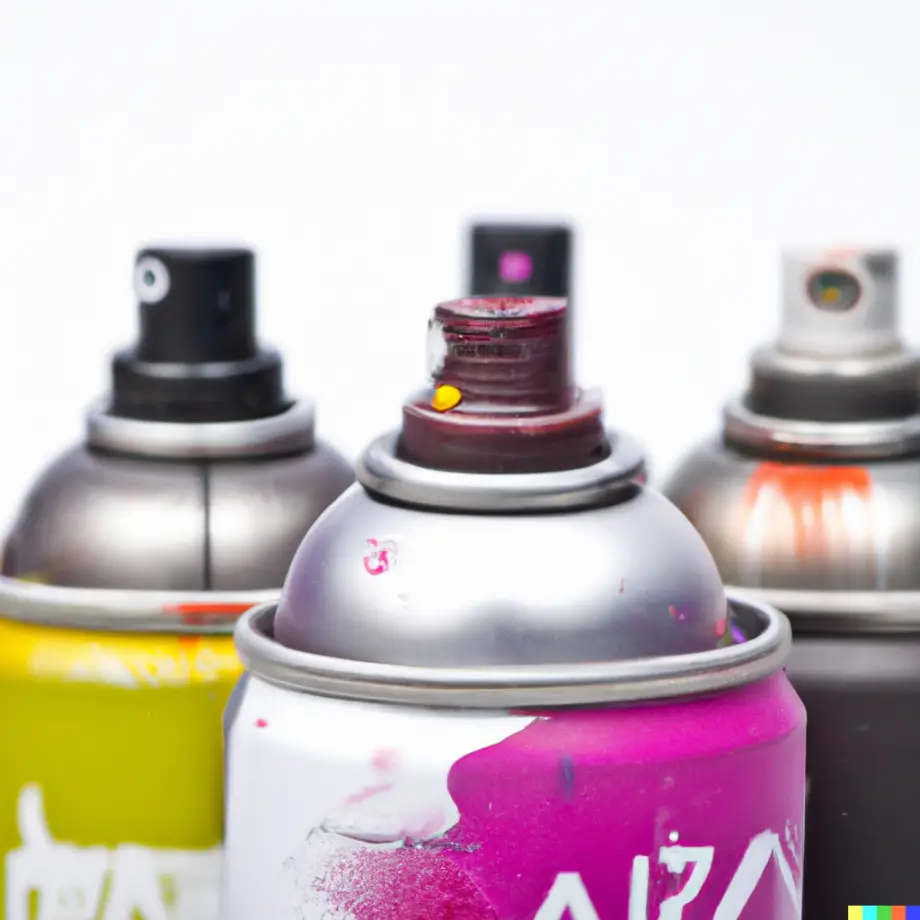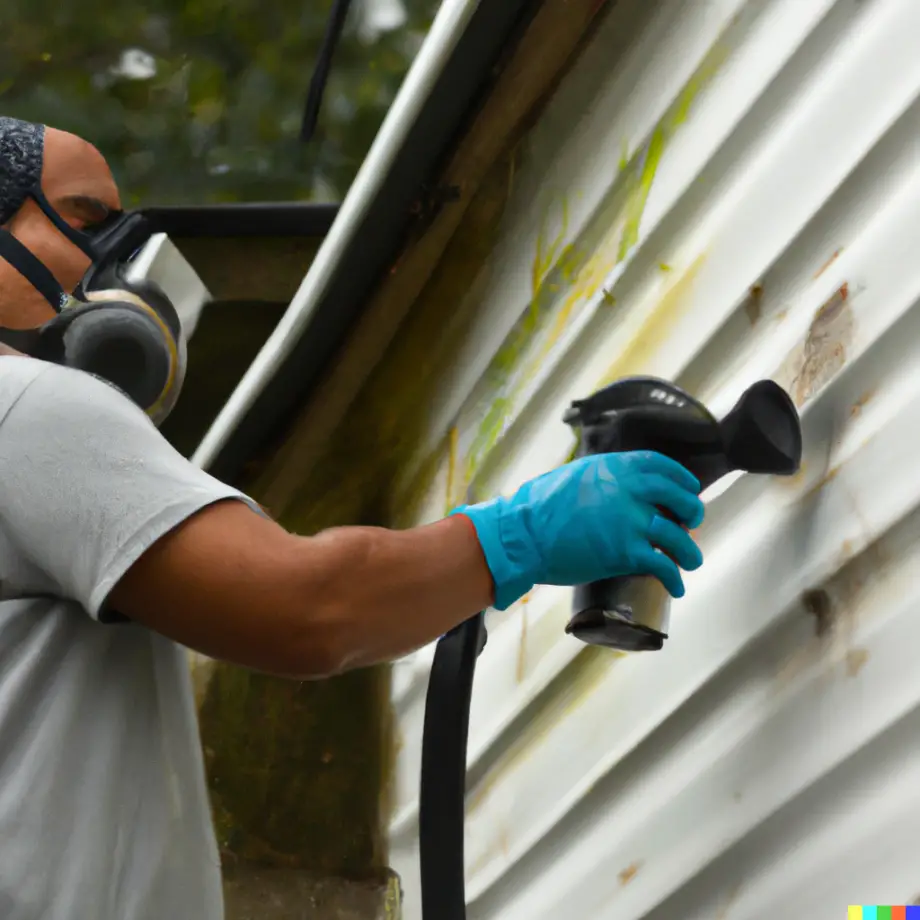Imagine this scenario: You’ve decided to tackle a DIY project over the weekend and are excited to start. You’ve picked out the perfect color and theme and are ready to pick your can.
But wait…
In the back of your mind, you’re worried about your kids being exposed to toxic paint chemicals – BUMMER!
That is exactly the case with me!
As a parent of two young girls, I am constantly concerned about their health and well-being. The thought of exposing them to toxicity is so unsettling that I dug up the internet and thoroughly researched before embarking on my next DIY project.
And if you are a concerned parent too, who’s wondering: is spray paint toxic, here’s is the answer:
“Spray paint can be toxic if inhaled or used in poorly ventilated areas. The chemicals in spray paint can irritate the eyes, nose, and throat, and prolonged exposure can lead to serious health problems. It’s important to follow the safety instructions and use protective equipment.”
The article further aims to shed more light on how you can achieve the same great results while keeping you and your loved ones safe.
Keep reading to make an informed decision before picking that can up for your next DIY!
Let’s Talk About What’s in Your Spray Paint
Spray paint is a commonly used product for various purposes, from DIY projects to professional painting jobs.
It’s convenient, effective, and adds perfect color and smooth texture to a surface.
But it’s also important to know what’s in your spray paint to avoid potential health hazards.
Composition of Spray Paint
The main composition of spray paint includes solvents, propellants, pigments, and binders. Each serves a different purpose.
- Solvents – Used to dissolve the other paint components and evaporate quickly to leave a smooth finish. Examples of solvents include toluene, xylene, and acetone.
- Propellants – Gases that push the paint out of the can and into the air. Propane, butane, and dimethyl ether are some commonly used propellants.
- Pigments – Give the paint its color and opacity. Some examples of pigments include cadmium, lead, chromium, and titanium dioxide.
- Binders – Hold the pigments together and help them adhere to the surface. Acrylic, epoxy, and urethane are widely used binders in paints.
Understanding Spray Paint Fumes
Spray paints combine paint, solvents, and propellants in a pressurized can. When the nozzle is pressed, the air pressure inside the can changes. This leads to the propellant pushing the paint out of the can, forming a fine mist sprayed onto the surface.
The mist results in spray fumes, a mixture of airborne particles and chemicals released into the air when the spray paint is applied.
Spray paint fumes are a common concern for anyone who uses spray paint, whether for a small DIY project or a large-scale professional job. These fumes can be harmful to human health and the environment.
Spray paint fumes can be inhaled or absorbed through the skin. These fumes can irritate the eyes, nose, and throat, as well as headaches, dizziness, and nausea.
Prolonged exposure to spray paint fumes can lead to more serious health problems, such as damage to the central nervous system, liver, and kidneys, and even increase your risk of cancer.
It’s important to understand the risks and take appropriate precautions.
Potential Health Hazards of Spray Paint Fumes
- Spray paint can contain volatile organic compounds (VOCs) that can harm human health, especially in high concentrations or with prolonged exposure.
- VOCs can irritate the eyes, nose, and throat, and cause headaches, dizziness, and nausea.
- VOCs are also notorious for contributing to air pollution and climate change.
- Certain pigments, such as lead and cadmium, can be toxic if ingested or inhaled.
Some of the most common VOCs used in spray paints are acetone, toluene, and xylene. These substances are associated with a high risk of potential health hazards and put our environment at risk. The below table lists the symptoms that occur after exposure to these substances and the organs that are affected:
| VOC | Symptoms | Affected Organs |
|---|---|---|
| Acetone | Irritation of eyes, nose, and throat; headache, dizziness, depression of central nervous system; dermatitis | Eyes, skin, respiratory system, central nervous system |
| Toluene | Irritation of eyes and nose; weakness, exhaustion, confusion, euphoria, dizziness, headache; dilated pupils, lacrimation; anxiety, muscle fatigue, insomnia; paresthesia; dermatitis; liver, kidney damage | Eyes, skin, respiratory system, central nervous system, liver, kidneys |
| Xylene | Irritation of eyes, skin, nose, and throat; dizziness, excitement, drowsiness, incoordination, staggering gait; vacuolization of the cornea; anorexia, nausea, vomiting, abdominal pain; dermatitis | Eyes, skin, respiratory system, central nervous system, gastrointestinal tract, blood, liver, kidneys |
Many studies have also been conducted to prove that prolonged exposure to spray paints can cause cancer.
The National Library of Medicine has a monograph that provides detailed information about the types of cancer and the chemicals that may cause them, especially in occupational painters.
Certain cancers, such as lung, bladder, and childhood leukemia, have been linked to exposure to paint chemicals.
Chemicals, such as Benzene, Formaldehyde, Toluene, Xylene, Ethylbenzene, Cadmium, and Lead, have been identified as possible causes of cancer.
To learn more about the association of spray paints with cancer, read our article, If Spray Paints Can Cause Cancer and 5 Ways You Can Avoid It.

How Toxic is Spray Paint?
Now that we already know that spray paint fumes are toxic, the question arises – how toxic are they?
The toxicity of spray paints depends on the type and amount of chemicals present in the paint.
Moreover, it also depends on your exposure to these chemicals. The longer and more frequent your exposure to spray paint fumes, the higher the risk of experiencing adverse health effects.
The level of toxicity also varies depending on the application method, with spray painting being more likely to release a higher concentration of harmful chemicals into the air than other methods.
How Long Does Spray Paint Smell Last?
After painting, giving enough time for the paint to dry and the fumes to dissipate is essential to consider the area safe.
The time required for spray paint to dry and become safe depends on various factors such as humidity, temperature, type of paint, and the surface being painted.
If you live in a hot climate, you’re more likely to enjoy a quick drying time.
In general, spray paint can take a few hours to several days to dry and become safe. To speed up the drying process, it’s recommended to apply thin coats of paint, keep the area well-ventilated, and allow ample time for each coat to dry before applying the next.
Once the spray paint is dry, it’s advisable to wait an additional 24-48 hours before using or occupying the painted surface to ensure maximum safety.
However, as a rule of thumb, you can use the newly painted room after 3 to 5 days of the spray paint application.
Is Spray Paint Toxic When Dry?
Fortunately, once the paint is dried completely, the toxic fumes dissipate, posing no health risks.
However, if your paint contains cadmium or lead, it can be toxic even after it has dried, depending on the paint’s condition.
Dry and undamaged paint is not a concern. But peeled and cracked paint, and sanding dried paint can release dust particles containing toxic chemicals into the air.
Lead and cadmium poisoning pose serious issues that can be irreversible in some cases. Some symptoms of heavy metal poisoning include abdominal pain, memory loss, joint and muscle pain, delayed growth in children, fatigue, loss of appetite, nausea, headache, dizziness, etc.
How Do I Know I Have Spray Paint Toxicity
If you experience any of the following symptoms of spray poisoning, it’s essential to seek fresh air immediately and consult a healthcare professional if the symptoms persist or worsen.
Here are some of the common spray paint toxicity symptoms:
- Headaches
- Dizziness
- Nausea
- Vomiting
- Shortness of breath
- Chest pain
- Irritation of the eyes, nose, throat, and lungs
- Skin irritation or rash
- Loss of coordination
- Fatigue
- Confusion
- Seizures
It’s important to note that symptoms can vary depending on the type, amount of chemicals in the spray paint and the individual’s sensitivity and exposure level.
How to Get Rid of Spray Paint Smell
Spray paint fumes’ side effects can be serious. To ensure safety, getting rid of the spray paint smell is optimal. You can use the following steps to get rid of the paint smell:
- Increase ventilation by opening windows and doors to allow fresh air to circulate.
- Use fans or air purifiers to help remove the fumes from the air.
- Place bowls of vinegar or activated charcoal in the painted area to absorb the odor.
- Use odor-neutralizing sprays or deodorizers specifically designed to eliminate paint smells.
- Clean surfaces with a mixture of water and baking soda or vinegar to help neutralize the odor.
Meanwhile, the above steps are crucial; avoid spending time in the painted area until the smell has dissipated entirely. Fumes can take a few hours to several days to dissipate, depending on the extent of the painting and the ventilation.
Precautions to Minimize Exposure to Spray Paint Fumes
- Always read and follow the safety instructions on the can of spray paint.
- Always use spray paint in a well-ventilated area, preferably outdoors or in a spray booth with adequate ventilation.
- Wear protective equipment, such as a mask and gloves, to minimize inhalation and skin contact with the chemicals in spray paint.
- Take frequent breaks and avoid prolonged exposure to spray paint fumes.
- Dispose of empty spray paint cans properly, following local regulations for hazardous waste.
Choosing Safer Spray Paint Options
- Look for low-VOC (volatile organic compound) or zero-VOC nontoxic spray paint options. These products contain fewer harmful chemicals and are safer for both human health and the environment.
- Water-based spray paints are also safer than traditional solvent-based spray paints. Learn our 7 Mind-Blowing Tips to Use Water-Based Paints on Wood.
Environmental Impacts of VOCs
VOCs can greatly impact the environment, ultimately harming human health.
- VOCs cause air pollution, smog, and respiratory problems in humans.
- They can damage crops and vegetation and worsen air quality.
- VOCs create unpleasant odors in consumer products.
- They contaminate soil and groundwater, affecting wildlife and human health.
- VOCs contribute to climate change as potent greenhouse gasses.

FAQs
Is spray paint toxic on the skin?
It’s common for spray paints to cause skin irritation, itching, and rash.
Is it safe to spray paint in the house?
You can safely spray paint your house if you have proper ventilation. Without optimal ventilation, the fumes can cause health issues when inhaled.
Is spray paint toxic to dogs?
Is spray paint toxic to cats, dogs, and other pets is a common concern for every pet owner. The answer is, yes, if ingested or inhaled, spray paint fumes can result in health problems such as respiratory distress, vomiting, diarrhea, and other symptoms in animals.
Can you die from spray paint fumes?
Yes, exposure to high concentrations of spray paint fumes can lead to death from respiratory failure or other severe health complications.
Conclusion
To summarize, spray paint can be toxic and harmful to human health and the environment. The fumes released during spray painting contain chemicals such as volatile organic compounds (VOCs) and can cause short-term and long-term health problems.
It is important to use spray paint in a well-ventilated area, wear protective equipment, and follow proper disposal procedures to minimize the risks associated with spray painting.
Additionally, opting for non-toxic, low-VOC spray paint alternatives and reducing the use of spray paint altogether can help mitigate the negative impacts on our health and environment.


